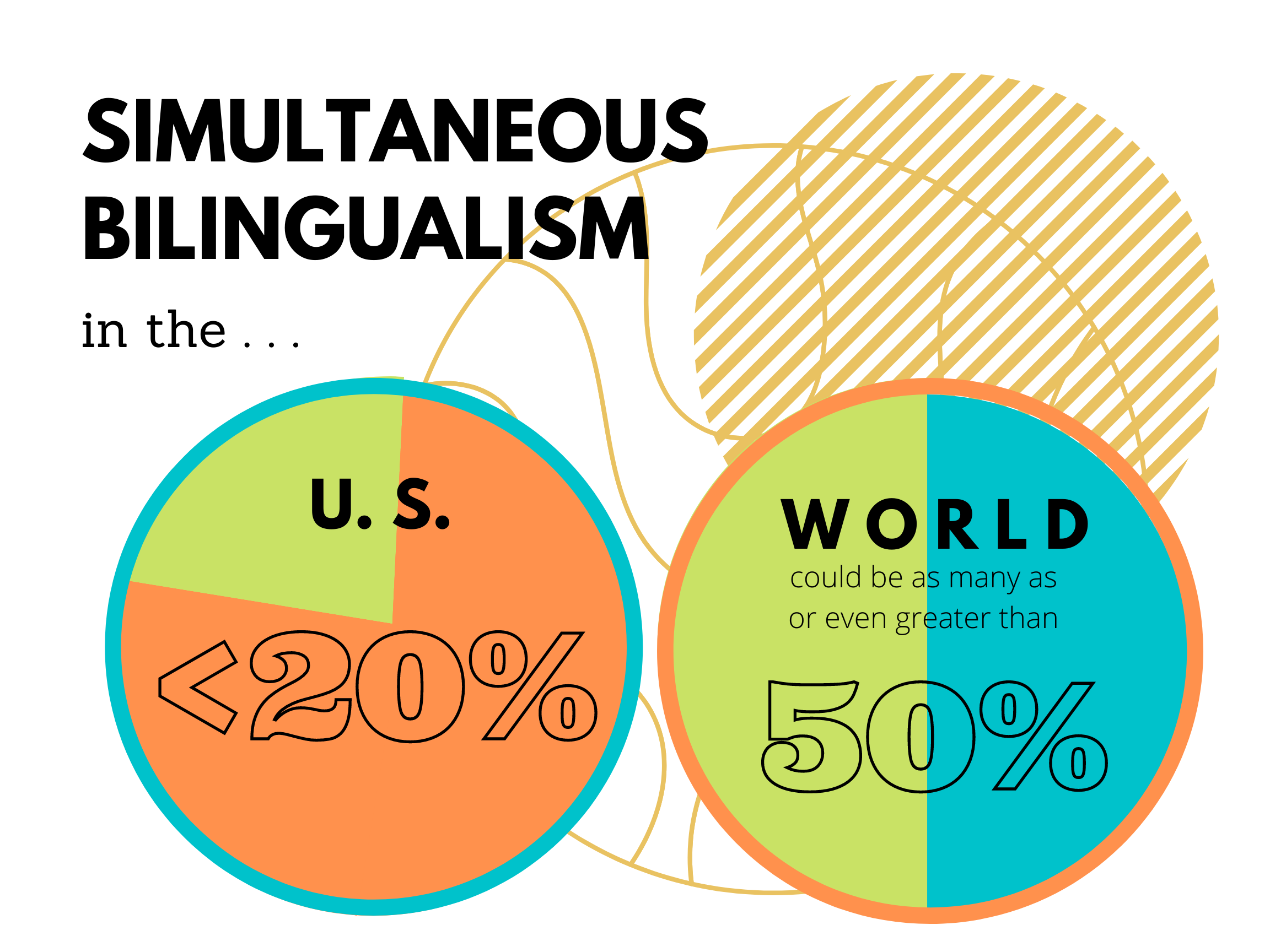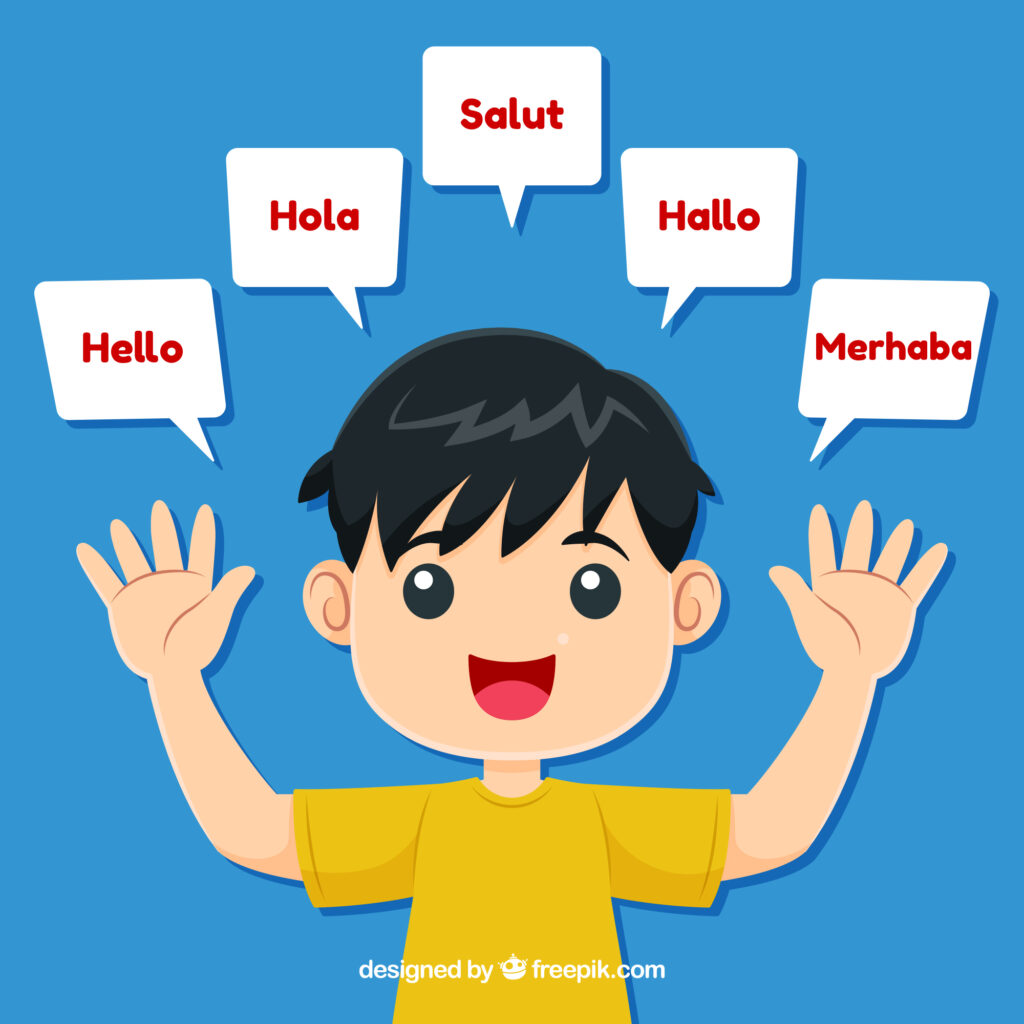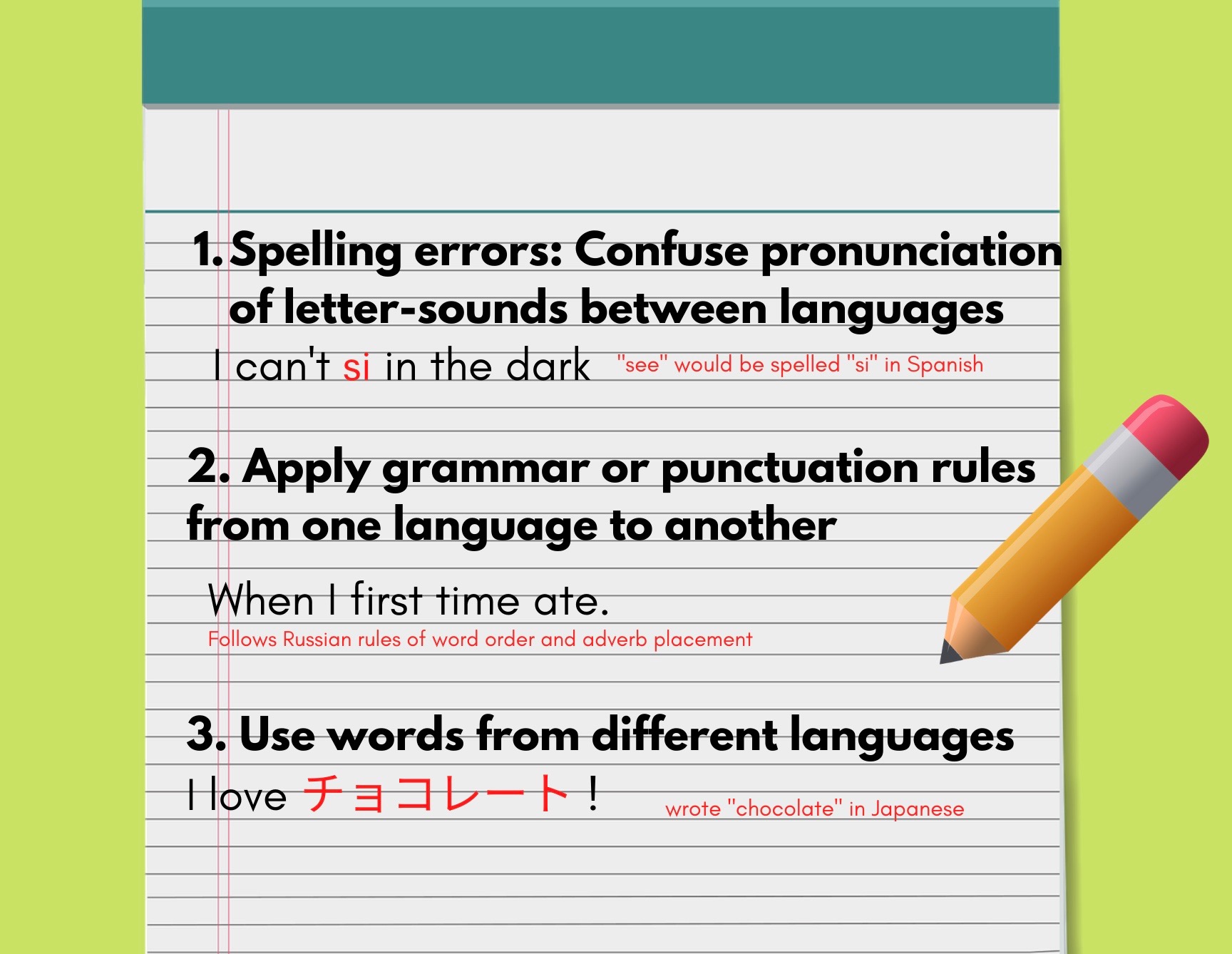◊ D E F I N I T I O N ◊
- Acquisition of fluency in two or more languages between 0-3 years at the same time
- Proficiency in languages is generally about equal
- May become dominant in one over time
http://www.youtube.com/watch?v=jATItFipzBg&ab_channel=13ruskie
Example: This 4-year-old can both understand and fluently speak 3 languages (13ruskie, 2012)!
◊ O R I G I N S ◊
- Both languages are usually acquired through parents and/or other caregivers and childcare providers (e.g., nannies, daycare leaders)
- Establish two separate language systems at the same time

◊ B Y T H E N U M B E R S ◊
- The exact prevalence of simultaneous bilingualism is unreported
- Estimates based on % of population that speaks multiple languages
- Simultaneous bilingualism is especially common among immigrant families
- 56% of children of immigrants are bilingual in the U.S.

◊ C U L T U R A L C O N S I D E R A T I O N S ◊
 Learn about the corresponding cultures of each language
Learn about the corresponding cultures of each language- Develop a unique bicultural identity influenced by both!
- Affects communication/literacy patterns, and intervention considerations
K E Y C H A R A C T E R I S T I C S
∴ C O M M U N I C A T I O N ∴
Verbal Skills:
- Important determinant in verbal fluency = vocabulary
- Tend to have smaller vocabularies in each language separately compared to their peers who are monolingual in either language
- May affect their conversational abilities and lexical access/retrieval
- But the size of their combined lexicon across both languages matches the size of these peers

- Tend to have smaller vocabularies in each language separately compared to their peers who are monolingual in either language
- Similarity of both languages may improve receptive vocabulary skills and grammatical awareness (i.e., Spanish-English bilingualism)
Translanguaging in Communication:
- Translanguaging = drawing on both languages to communicate
- Code-switching = altering between languages within an exchange of communication
- Communicative skills of children who are bilingual with weaker verbal working memories may be negatively effected with greater exposure to code-switching
- However, code-switching in the remaining children who are bilingual may be more of a linguistic choice that exhibits commendable language skills

(Esen, 2019)
- Code-switching may also, however, account for lexical gaps in a child’s vocabulary in one of the languages in certain uses.
Cultural Effects:
- Culture is an important linguistic factor for a child who is simultaneously bilingual
- They pick up on culturally-determined communicative behaviors of each language (body language, gestures, eye contact, etc.)
- Begin to seamlessly use/switch between them when speaking in each language
∴ L I T E R A C Y ∴
Reading Trends:

- Strengths:
- Phonological awareness: A key component of emergent literacy, which predicts later reading ability, and decoding
- Ability to process text on deeper level
- Reading comprehension and irregular word reading skills
- Areas of Growth:
- Disadvantages depend on individual differences in language exposure (e.g., less exposure to one or both language(s) → smaller vocabulary → weaker performance on reading tasks)
- Otherwise, mirror the same reading patterns/timeline as those who are monolingual
Writing Patterns:
- Like with communication, often use both language systems to write (code-switching)

Spontaneous Biliteracy:
- May acquire the ability to read and write in both languages even if only formally taught in one!
- How? Transfer literacy skills and understanding of text from one to the other
∴ ∴ ∴
Key Takeaway: If children mix both languages when communicating and writing…
- Not necessarily a sign of language weakness or delay
- Actually indicates proficiency → using all linguistic resources to communicate
I N T E R V E N T I O N S
SUPPORTING children who are simultaneously bilingual
♥ C O M M U N I C A T I O N ♥
Children who are simultaneously bilingual may suffer linguistically due to lack of consistent and equal exposure to both languages. Environment-altering interventions can help to better control and manipulate exposure.
- One-parent, one-language: a language-separation strategy where the child speaks one language with one parent and the other language with the other parent
- Benefits – equal exposure to and consistent use of both languages from a young age and through developmental period
- Challenges – may feel unnatural to implement, harder to control once the child’s immediate environment expands outside of the home
-
Example of OPOL (One-Parent One-Language): a father’s personal experience, advice, and challenges as he raises his son in an OPOL household (MosaLingua, 2018).
- Separation of Language Environments: speaking only one language at home and only the other language at school
- Requirements – send the child to a monolingual school, both parents are fluent in the other language, content of home language should be as dense as language learned in school (can be achieved through stories, cultural events, etc.)
♥ L I T E R A C Y ♥
- Paired literacy: a 50:50 approach that teaches reading and writing in both languages simultaneously
- Usually target vocabulary
Example of paired literacy: Watch the first few minutes to see how educators can connect two languages through translation and cognates to improve literacy in both (SEAL, 2018).
- Some other specific paired literacy interventions:
- Literacy Squared: K-5; daily classroom instruction in both languages
- Bilingual dialogic book reading: Caregivers and clinicians lead weekly interactive reading sessions in two different languages
- extend program: preschool; teachers lead reading lessons in one language, caregivers review texts in other language at home
Example of an interactive book reading for young children who are bilingual. Notice how both languages are incorporated (KidTimeStoryTime, 2018).
♥ ♥ ♥
Effective interventions for children who are simultaneously bilingual…
 Reveal connections between the two languages
Reveal connections between the two languages- Analyze how children transfer reading/writing knowledge between the two languages to identify areas of growth in either one
- Use multicultural, culturally responsive texts and literacy resources
- Involve caregivers, emphasizing the importance of a child’s home language and culture
M O R E Q U E S T I O N S ?
GUIDES for parents and teachers
- Bilingual Service Delivery
- The Hanen Centre
- Information Toolkit
- Multilingual Book Resources
- Teaching students who are bilingual
R E F E R E N C E S
Videos:
13ruskie. (2012, October 3). 4 year old girl speaks 3 languages (English, Russian, Spanish) [Video]. YouTube. https://www.youtube.com/watch?v=jATItFipzBg&feature=youtu.be&ab_channel=13ruskie
KidTimeStoryTime. (2018, September 25). Books for kids: A paintbrush for Paco (read in English with a dash of Spanish) [Video]. YouTube. https://www.youtube.com/watch?v=35OCmQb5n4c&feature=youtu.be&list=PL0PE1OVfRIs3KrekLxN6KiwdK-Wn6WyPP&ab_channel=KidTimeStoryTime
MosaLingua. (2018, October 20). How to raise a bilingual child: my personal experience and tips [Video]. YouTube. https://www.youtube.com/watch?v=84IbZrMSNhA&feature=emb_logo.
SEAL. (2018, September 24). Cross language connections in the classroom [Video]. YouTube. https://www.youtube.com/watch?v=TpPa7MZC4O0&feature=youtu.be&ab_channel=SEAL
Photos from:
- FreePik
- Pixabay
- Esen, S. (2019). Reasons for code switching [online image]. Owlcation. https://owlcation.com/humanities/Code-Switching-Definition-Types-and-Examples-of-Code-Switching
Interested in the research? Full list of references here.
By Ashley Byck and Sydney Takemoto
